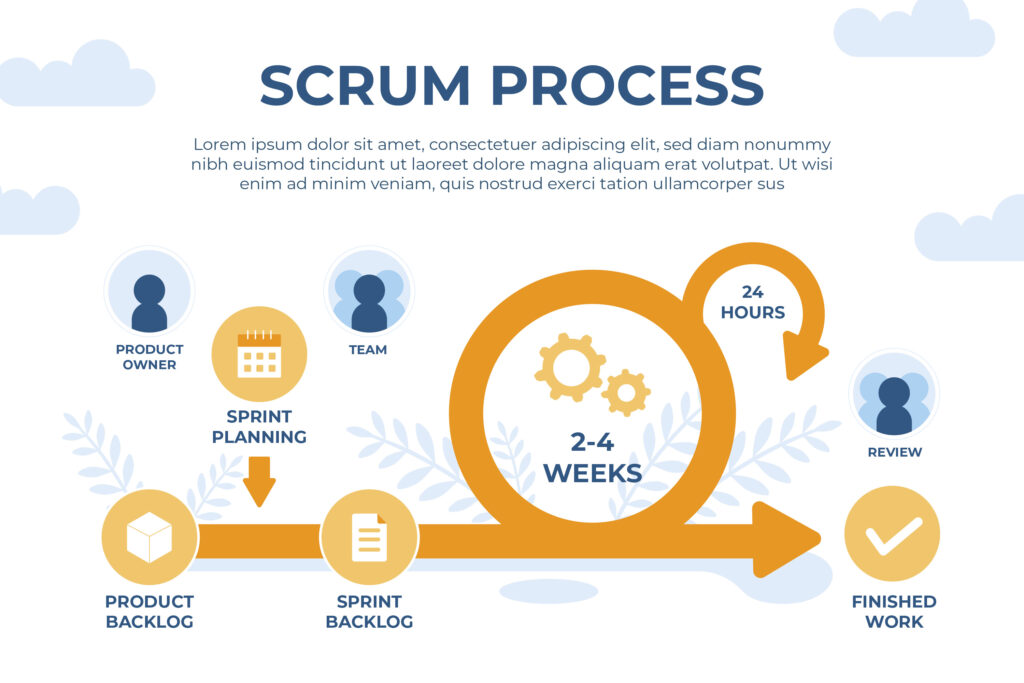
Scrum: A better way to get work done
Scrum is a framework for software development projects, which is based on iterative and incremental development cycles. It is used to manage complex software development projects and is based on collaboration between self-organizing and cross-functional teams.
Many software development teams use Scrum as their preferred project management framework due to its popularity and agility. The framework comprises a set of processes and practices that enable teams to deliver high-quality software products faster.
Ok, but what is Scrum?

Photo credits by Freepik.
Scrum is an iterative, incremental framework for managing complex projects. It focuses on delivering software products quickly and efficiently.
Scrum is established on the idea of self-organizing teams and is designed to allow teams to adapt quickly to changing requirements. It consists of three key elements: sprints, backlogs, and retrospectives.
Sprints are short cycles of work, usually two to four weeks in duration. During each sprint, teams work on a set of tasks that are chosen from a backlog.
The backlog is a list of all tasks that need to be completed, along with their priority. The sprint is divided into those backlog tasks, and each task is assigned to a team member. That way, the team can work together to complete the tasks before the end of the sprint.
At the end of each sprint, the team holds a retrospective, which is a meeting where they review what went well and what could be improved. This practice helps the team to continuously improve their processes and become more efficient.

Photo credits by Freepik.
And how can a team use Scrum?
As said before, Scrum is a straightforward framework that’s designed to help manage intricate software development projects. It comprises a sequence of sprints, with each one aimed at accomplishing a specific set of tasks. This solution offers a well-defined structure and goals to work towards, while also allowing teams the flexibility to decide how to achieve these objectives based on their unique circumstances.
The success of Scrum depends on the team’s ability to work together to deliver high-quality software products quickly and efficiently. To do this, teams must have a clear understanding of the project’s goals and objectives, as well as the tools and processes used to achieve them.
The first step in implementing Scrum is to create a sprint plan. This plan should include the tasks that need to be completed, the timeline for completing them, and the resources that will be needed. Once the plan is in place, the team can begin working on the tasks.
Each task should be broken down into smaller, manageable chunks and assigned to the team members who are best suited to complete them. The team should also create a backlog of tasks that need to be completed, and prioritize them based on their importance and urgency.
Throughout the sprint, the team should track their progress and keep a record of the work that has been completed. At the end of the sprint, the team should review the work that was completed and identify areas for improvement. This is done during the retrospective, where the team reviews what went well and what could be improved.
For teams that are new to Scrum, there are several tools available to help them manage the process. These tools include project management software, task tracking tools, and sprint tracking tools. These tools help teams to stay organized and ensure that the project is progressing as planned.
Again, Scrum is a powerful framework for managing complex projects and delivering high-quality software products quickly. By using a clearly defined process, teams can work together to complete tasks and deliver products faster. As teams become more experienced with Scrum, they can use it to develop better-customized processes and become even more efficient.

Photo credits by Freepik.
Learn how to optimize this powerful framework
In this comprehensive guide, we’ll cover all the basics of Scrum, from the core concepts to the tools and techniques for implementing and optimizing Scrum. We’ll also provide real-world examples of how teams have used Scrum to improve their software development processes and deliver better products.
Benefits of Scrum
Scrum is an agile project management framework for a reason. It provides several benefits that can help teams deliver better software products faster.
The main benefit of Scrum is that it allows teams to quickly adapt to changing requirements. Teams can easily adjust the scope of the project and prioritize tasks based on the current needs. This makes it easy to deliver high-quality, customer-focused products.
This solution also enables teams to collaborate more effectively, which helps them identify problems earlier and deliver better products faster. By using a sprint-based process, teams can quickly identify areas that need improvement and make changes accordingly.
Finally, Scrum enables teams to measure their progress more accurately. By tracking the progress of each sprint, teams can identify areas of improvement and adjust the process as they wish.
Tools and Techniques for Optimizing Scrum
Once teams have implemented Scrum, there are several tools and techniques they can use to optimize their process. These include setting up a daily stand-up meeting, automating the reporting process, and using customer feedback to prioritize tasks.
The daily stand-up meeting is a short meeting that takes place each day. During the meeting, team members share their progress and any issues they may be facing. This helps teams stay on track and identify potential problems early.
Automating the reporting process is also beneficial. By automating the reporting process, teams can save time and ensure that everyone is on the same page. This helps teams stay organized and ensure that they are making progress on their tasks.
Finally, teams should use customer feedback to prioritize tasks. By listening to customer feedback, teams can identify areas of improvement and ensure that they are delivering the best possible product.
Why Scrum?
Scrum is a powerful framework for managing complex projects and delivering high-quality software products quickly. By using a clearly defined process, teams can work together to complete tasks and deliver products faster. As teams become more experienced with Scrum, they can use it to develop better processes and become even more efficient. Scrum processes also help companies to easily adapt to requirements that are changing rapidly, and create a product that matches the business objectives that are emerging fast. On top of that, Scrum is not a methodology, but a framework that can be used within other Agile methods, such as Kanban, bringing even more flexibility to the table.
By following the steps outlined in this guide, teams can successfully implement and optimize Scrum. They can create a sprint plan, track their progress, and use customer feedback to prioritize tasks. Teams can also use a variety of tools and techniques to optimize their process and become more efficient.
If you want to know more about Scrum and other agile methods, and also how to use them, click here and contact one of our specialized consultants for more information.
Don't miss any of our content
Sign up for our newsletter
Our Social Media
Most Popular

Didn’t find what you were looking for?
Get in touch with our team (786) 558-1665 or send an email to [email protected]. If you prefer, click here and schedule an appointment.







